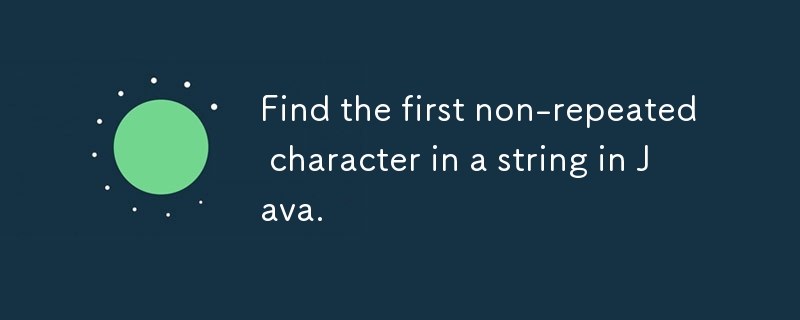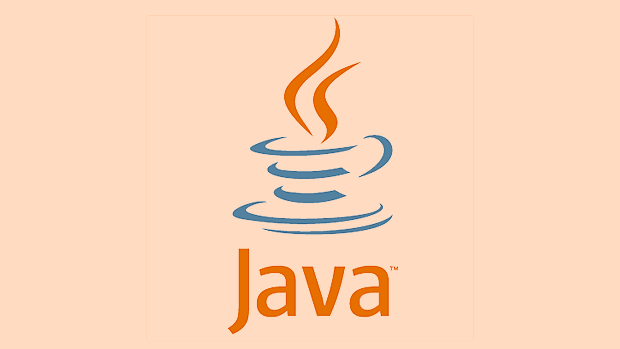Find the first non-repeated character in a string in Java.
Jul 09, 2025 am 01:05 AMThe first non-repeat character can be achieved in three ways. Method 1: Use HashMap to count the character frequency and traverse the string twice to find the first character with 1 occurrences, which is suitable for conventional scenarios; Method 2: Use LinkedHashMap to maintain the insertion order, and traverse the key-value pair to return the first character with 1 count. Although the string traversal is reduced, there are still two traversals; Method 3: Use array to count the frequency (limited ASCII characters), which has better performance and is suitable for long strings and limited character sets.

To find the first non-repetitive character in a string, Java provides multiple implementations. The most common thing is to use a hash table (such as HashMap ) to count the number of occurrences of each character, and then iterate over the string again to find the first character that only appears once.

Here is a simple and direct implementation method:
Method 1: Use HashMap to count the number of characters
This is the most common practice, applicable to most cases and is more intuitive to understand.

import java.util.HashMap;
public class FirstNonRepeatedCharacter {
public static char findFirstNonRepeated(String str) {
HashMap<Character, Integer> charCount = new HashMap<>();
// The first traversal: count the number of occurrences of each character for (char c : str.toCharArray()) {
charCount.put(c, charCount.getOrDefault(c, 0) 1);
}
// The second traversal: find the first character with 1 occurrences for (char c : str.toCharArray()) {
if (charCount.get(c) == 1) {
return c;
}
}
return '\0'; // If not found, return empty character}
public static void main(String[] args) {
String input = "swiss";
char result = findFirstNonRepeated(input);
System.out.println("The first non-repeat character is: " (result != '\0' ? result : "None"));
}
}In this example, we did two things:
- Use
getOrDefaultto simplify counting logic; - The second round traversal of the original string, instead of the hash table's key collection, this ensures order.
Applicable scenarios:

- When the string length is not particularly large (such as within a few thousand);
- The code needs to be kept clear and easy to maintain.
Method 2: Use LinkedHashMap to maintain the insertion order
If you want to complete statistics and searches in one traversal, consider using LinkedHashMap .
import java.util.LinkedHashMap;
import java.util.Map;
public class FirstNonRepeatedCharacter2 {
public static char findFirstNonRepeated(String str) {
Map<Character, Integer> map = new LinkedHashMap<>();
for (char c : str.toCharArray()) {
map.put(c, map.getOrDefault(c, 0) 1);
}
for (Map.Entry<Character, Integer> entry : map.entrySet()) {
if (entry.getValue() == 1) {
return entry.getKey();
}
}
return '\0';
}
}advantage:
- Taking advantage of the orderliness of
LinkedHashMap; - A second full traversal of the original string can be avoided.
shortcoming:
- If there are a large number of duplicate characters in the string, it may cause the final returned character to be not the earliest (because the previous duplicates were skipped);
- In fact, there are still two "traversals", but the objects are different.
Method 3: Use array optimization (ASCII characters only)
If you are sure that the input string contains only standard ASCII characters (i.e. up to 256 possibilities), you can replace the hash table with a fixed size array.
public class FirstNonRepeatedCharacter3 {
public static char findFirstNonRepeated(String str) {
int[] count = new int[256];
// First traversal: Statistical frequency for (int i = 0; i < str.length(); i ) {
count[str.charAt(i)] ;
}
// The second traversal: find the first character with a frequency of 1 for (int i = 0; i < str.length(); i ) {
if (count[str.charAt(i)] == 1) {
return str.charAt(i);
}
}
return '\0';
}
}advantage:
- Better performance, especially when strings are very long;
- Array access is faster than hashing.
Notice:
- This method is only applicable to cases where the character set range is known;
- If there are Unicode characters, it is not suitable.
Let's summarize
- Recommended usage : If the data volume is not large, it is safest to use
HashMapdirectly. - Performance priority : Use arrays, provided that the character set is limited.
- Want to keep the order : Use
LinkedHashMap. - More modern writing : Java 8's Stream API can also be used, but the readability and efficiency may not be better.
Basically these are the methods. Which one you choose depends on your specific needs, but the above are relatively general and easy to understand.
The above is the detailed content of Find the first non-repeated character in a string in Java.. For more information, please follow other related articles on the PHP Chinese website!

Hot AI Tools

Undress AI Tool
Undress images for free

Undresser.AI Undress
AI-powered app for creating realistic nude photos

AI Clothes Remover
Online AI tool for removing clothes from photos.

Clothoff.io
AI clothes remover

Video Face Swap
Swap faces in any video effortlessly with our completely free AI face swap tool!

Hot Article

Hot Tools

Notepad++7.3.1
Easy-to-use and free code editor

SublimeText3 Chinese version
Chinese version, very easy to use

Zend Studio 13.0.1
Powerful PHP integrated development environment

Dreamweaver CS6
Visual web development tools

SublimeText3 Mac version
God-level code editing software (SublimeText3)

Hot Topics
 Difference between HashMap and Hashtable?
Jun 24, 2025 pm 09:41 PM
Difference between HashMap and Hashtable?
Jun 24, 2025 pm 09:41 PM
The difference between HashMap and Hashtable is mainly reflected in thread safety, null value support and performance. 1. In terms of thread safety, Hashtable is thread-safe, and its methods are mostly synchronous methods, while HashMap does not perform synchronization processing, which is not thread-safe; 2. In terms of null value support, HashMap allows one null key and multiple null values, while Hashtable does not allow null keys or values, otherwise a NullPointerException will be thrown; 3. In terms of performance, HashMap is more efficient because there is no synchronization mechanism, and Hashtable has a low locking performance for each operation. It is recommended to use ConcurrentHashMap instead.
 What are static methods in interfaces?
Jun 24, 2025 pm 10:57 PM
What are static methods in interfaces?
Jun 24, 2025 pm 10:57 PM
StaticmethodsininterfaceswereintroducedinJava8toallowutilityfunctionswithintheinterfaceitself.BeforeJava8,suchfunctionsrequiredseparatehelperclasses,leadingtodisorganizedcode.Now,staticmethodsprovidethreekeybenefits:1)theyenableutilitymethodsdirectly
 How does JIT compiler optimize code?
Jun 24, 2025 pm 10:45 PM
How does JIT compiler optimize code?
Jun 24, 2025 pm 10:45 PM
The JIT compiler optimizes code through four methods: method inline, hot spot detection and compilation, type speculation and devirtualization, and redundant operation elimination. 1. Method inline reduces call overhead and inserts frequently called small methods directly into the call; 2. Hot spot detection and high-frequency code execution and centrally optimize it to save resources; 3. Type speculation collects runtime type information to achieve devirtualization calls, improving efficiency; 4. Redundant operations eliminate useless calculations and inspections based on operational data deletion, enhancing performance.
 What is an instance initializer block?
Jun 25, 2025 pm 12:21 PM
What is an instance initializer block?
Jun 25, 2025 pm 12:21 PM
Instance initialization blocks are used in Java to run initialization logic when creating objects, which are executed before the constructor. It is suitable for scenarios where multiple constructors share initialization code, complex field initialization, or anonymous class initialization scenarios. Unlike static initialization blocks, it is executed every time it is instantiated, while static initialization blocks only run once when the class is loaded.
 What is the Factory pattern?
Jun 24, 2025 pm 11:29 PM
What is the Factory pattern?
Jun 24, 2025 pm 11:29 PM
Factory mode is used to encapsulate object creation logic, making the code more flexible, easy to maintain, and loosely coupled. The core answer is: by centrally managing object creation logic, hiding implementation details, and supporting the creation of multiple related objects. The specific description is as follows: the factory mode handes object creation to a special factory class or method for processing, avoiding the use of newClass() directly; it is suitable for scenarios where multiple types of related objects are created, creation logic may change, and implementation details need to be hidden; for example, in the payment processor, Stripe, PayPal and other instances are created through factories; its implementation includes the object returned by the factory class based on input parameters, and all objects realize a common interface; common variants include simple factories, factory methods and abstract factories, which are suitable for different complexities.
 What is type casting?
Jun 24, 2025 pm 11:09 PM
What is type casting?
Jun 24, 2025 pm 11:09 PM
There are two types of conversion: implicit and explicit. 1. Implicit conversion occurs automatically, such as converting int to double; 2. Explicit conversion requires manual operation, such as using (int)myDouble. A case where type conversion is required includes processing user input, mathematical operations, or passing different types of values ??between functions. Issues that need to be noted are: turning floating-point numbers into integers will truncate the fractional part, turning large types into small types may lead to data loss, and some languages ??do not allow direct conversion of specific types. A proper understanding of language conversion rules helps avoid errors.
 Why do we need wrapper classes?
Jun 28, 2025 am 01:01 AM
Why do we need wrapper classes?
Jun 28, 2025 am 01:01 AM
Java uses wrapper classes because basic data types cannot directly participate in object-oriented operations, and object forms are often required in actual needs; 1. Collection classes can only store objects, such as Lists use automatic boxing to store numerical values; 2. Generics do not support basic types, and packaging classes must be used as type parameters; 3. Packaging classes can represent null values ??to distinguish unset or missing data; 4. Packaging classes provide practical methods such as string conversion to facilitate data parsing and processing, so in scenarios where these characteristics are needed, packaging classes are indispensable.
 What is the `final` keyword for variables?
Jun 24, 2025 pm 07:29 PM
What is the `final` keyword for variables?
Jun 24, 2025 pm 07:29 PM
InJava,thefinalkeywordpreventsavariable’svaluefrombeingchangedafterassignment,butitsbehaviordiffersforprimitivesandobjectreferences.Forprimitivevariables,finalmakesthevalueconstant,asinfinalintMAX_SPEED=100;wherereassignmentcausesanerror.Forobjectref






